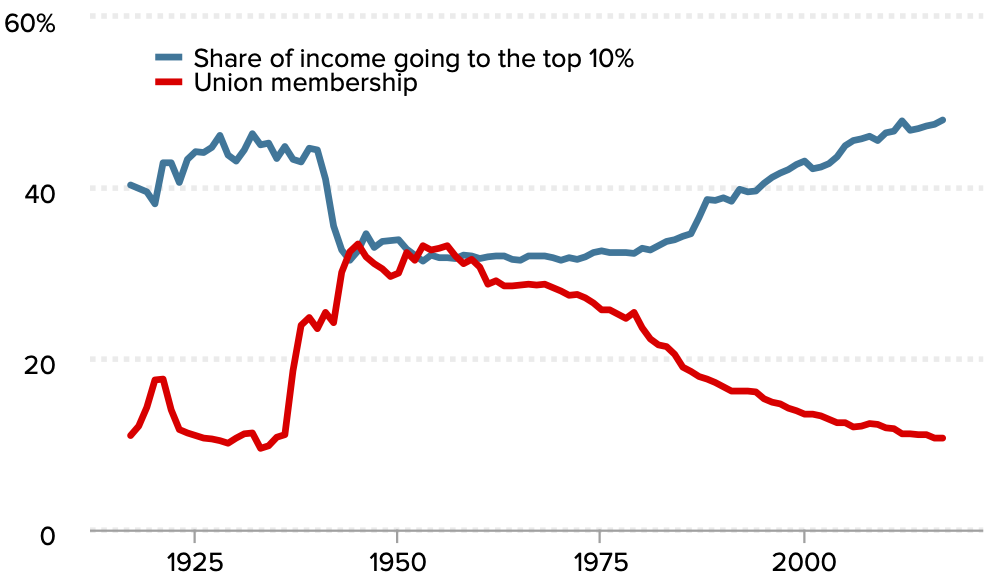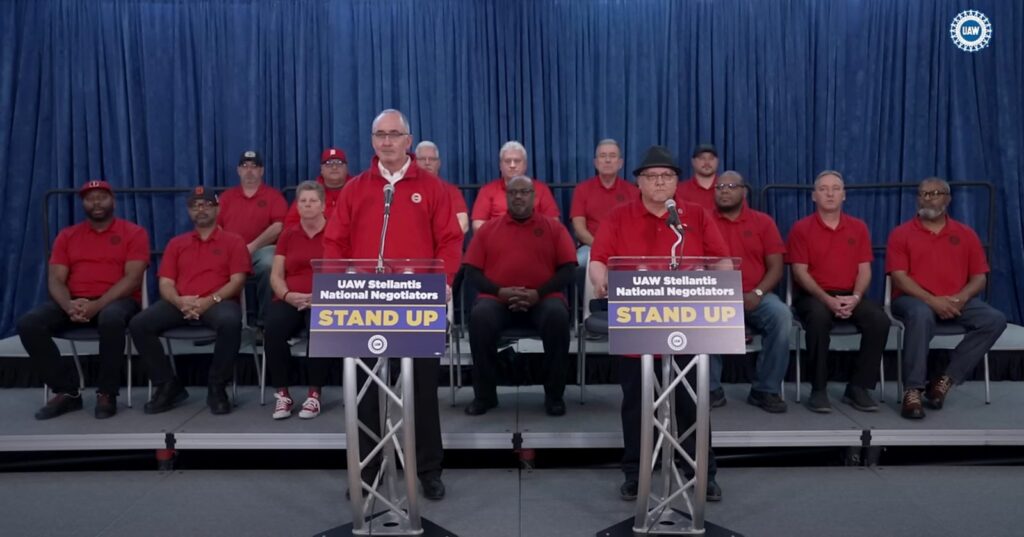
Tesla has announced that it will raise factory worker pay for some workers at its Nevada Gigafactory by 10% or more. The news comes not long after UAW’s historic strike wins, in which it earned 25% pay increases at all of the Big Three American automakers.
After VW, Hyundai, Toyota, and Honda did the same recently, this shows how union wins tend to affect entire industries, raising conditions for even nonunionized companies who have to compete for workers.
CNBC reported that Tesla internal documents confirmed that workers at the Gigafactory will receive “cost of living adjustments” of between $2.00 and $8.30 per hour, with raises of 10% or more for most hourly workers at the plant. It will also “streamline” wage tiers and reduce the differences in pay between them.
These are two major points of the UAW negotiation, which not only sought raises but also cost-of-living adjustments (which UAW gave up as part of negotiations after the 2008 financial crisis and only just got back in this year’s negotiations) and the elimination or reduction of tiered pay structures. CNBC’s report doesn’t state whether Tesla’s timelines have been made shorter, but the wage progressions will be compressed to have fewer tiers.
Tesla is currently in the sights of UAW as a potential target for unionization. But UAW is not the only union targeting Tesla. The automaker is currently facing a strike from workers in Sweden as the nation’s largest industrial union, IF Metall, wants Tesla to sign a collective bargaining agreement (an agreement the likes of which 90% of Swedish workers are covered). This strike has been gradually expanding via sympathy strikes over time.
The new pay raises will take effect starting January 2024, just two weeks from now.
Other companies have also raised pay
Tesla’s raises aren’t the only similar recent announcement from a nonunionized company.
Last month, Volkswagen of America announced that it would increase wages in a press release. It was pretty light on details but said that the wage increase would start in December and that a compressed wage progression timeline would begin in February.
Volkswagen of America annually evaluates compensation for our production team members at the end of the year to ensure we continue to offer a competitive and robust compensation package designed to attract and motivate employees who make our daily operations possible at the plant.
Prior to that, Hyundai announced a 25% pay increase for nonunionized workers by 2028, matching the headline 25% gain that UAW won in its negotiations. Hyundai COO Jose Munoz said, “Hyundai continuously strives to maintain competitive wages and benefits commensurate to industry peers.”
Also, Honda raised the wages of some workers by 11%, along with a faster progression to the top of the wage scale and additional benefits like child care and student loan help. Honda said it “continuously reviews our total rewards packages to ensure we remain competitive within our industry.” The company also said, “We will continue to look for opportunities to ensure that we provide an excellent employment experience for Honda associates.”
And Toyota took the opportunity to hike the pay of most of its US assembly workers by 9.2% immediately after the UAW deals were announced. After Toyota’s pay hike, UAW President Shawn Fain recognized that it was a response to his union’s new contract, saying, “Toyota, if they were doing it out of the kindness of their heart, they could have chosen to do it a year ago.”
The “UAW Bump”
Fain called these wage increases “the UAW bump” and said, “UAW, that stands for ‘U Are Welcome.’”
UAW wants to maintain this momentum and has openly stated that it wants to unionize more nonunionized companies in the US. In UAW’s original strike victory announcement, Fain said that it plans to come back to the bargaining table in 2028 on May 1, otherwise known as May Day or International Workers’ Day, but that time, it “won’t just be with a Big Three, but with a Big Five or Big Six.”
At the time, he didn’t specify who exactly those extra two or three companies would be, but later, we found out when UAW launched a campaign to unionize the entire auto industry at once. So perhaps UAW is aiming for even more than a Big Five or Big Six at this point.
Tesla specifically has been brought up, too. President Biden said he would support UAW’s push to unionize Tesla and Toyota, with Honda’s pay raise announcement coming right after that well-publicized meeting.
(Note: this article has been updated multiple times as more automakers have announced pay raises for US factory workers since UAW’s win)
Electrek’s Take
Unions are having a bit of a moment in the US, reaching their highest popularity ever since surveys started asking about them.
Much of union popularity has been driven by COVID-related disruptions across the economy, with workers becoming unsatisfied due to mistreatment (labeling everyone “essential,” companies ending work-from-home) and with the labor market getting tighter with over 1 million Americans dead from the virus and another 2-4 million (and counting) out of work due to long COVID.
Unions have seized on this dissatisfaction to build momentum in the labor movement, with unions striking successfully across many industries and organizers starting to organize workforces that had previously been nonunion.
Announcements like these show how high union membership has a tendency to improve working conditions for every worker and why the US has had gradually lower pay and worse conditions over the decades since union membership peaked. It’s really not hard to see the influence when you plot these trends against each other.


It’s quite clear that lower union membership has resulted in lower inflation-adjusted compensation for workers, even as productivity has skyrocketed. As workers have produced more and more value for their companies, those earnings have gone more and more to their bosses rather than to the workers who produce that value. And it all began in the 80s, around the time of Reagan – a timeline that should be familiar to those who study social ills in America.
Conversely, these raises show the impact that unionized workers can have, not only for their own shops but for nonunionized workplaces as well. If workers gain a big pay increase in one part of an industry, all of a sudden, workers at other companies might start thinking they want to jump ship, maybe move over to another company where they can get better pay or better conditions. To retain workers, companies then need to raise wages.
In addition, nonunionized companies may want to keep their employees nonunionized and thus see the pay raises as a way to satiate their employees into maintaining the status quo. If workers at Toyota see that UAW workers are getting huge pay increases and lots of additional benefits, maybe they’ll think that UAW can bring them the same benefits and start talking about unionizing.
Companies generally think they should avoid having a unionized workforce because a unionized workforce means more pay for workers, which to them means less pay for the executives and shareholders making the decisions. So they’ll offer whatever carrots they can to keep workers from organizing to have their voices heard collectively. Individually, workers have little influence over what their pay and conditions should be.
All of this isn’t just true in the US but also internationally. If you look at other countries with high levels of labor organization, they tend to have more fair wealth distribution across the economy and more ability for workers to get their fair share.
We’re seeing this in Sweden right now, as Tesla workers are striking for better conditions. Since Sweden has a 90% collective bargaining coverage, it tends to have a happy and well-paid workforce, and it seems clear that these two things are correlated. And while that strike is continuing, meaning we haven’t yet seen the effects of it, most observers think that the workers will eventually get what they want since collective bargaining is so strong in that country.
These are all reasons why, as I’ve mentioned in many of these UAW-related articles, I’m pro-union. And I think everyone should be – it only makes sense that people should have their interests collectively represented and that people should be able to join together to support each other and exercise their power collectively instead of individually.
This is precisely what companies do with industry organizations, lobby organizations, chambers of commerce, and so on. And it’s what people do when sorting themselves into local, state, or national governments. So naturally, workers should do the same. It’s just fair.
And it’s clear that it helps – so even if you aren’t unionized yourself or have a job that doesn’t lend well to unionization, you should probably be happy about other union efforts since they tend to buoy entire economies for the people who are creating the value in the first place – the workers.
FTC: We use income earning auto affiliate links. More.

